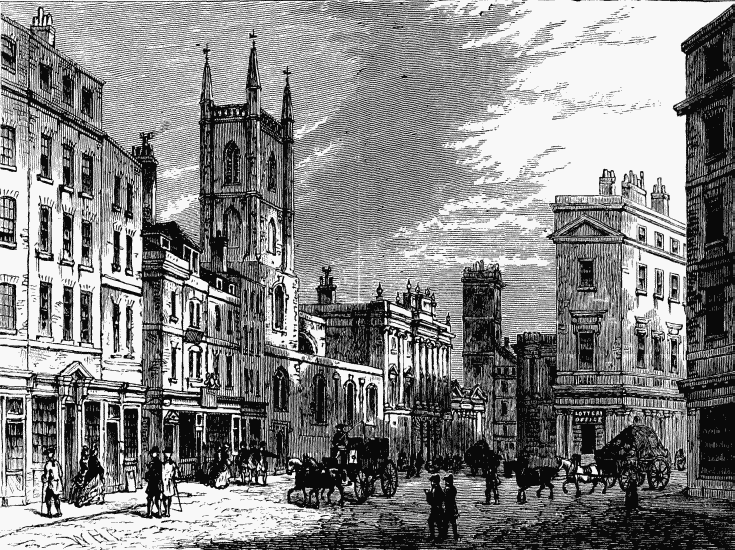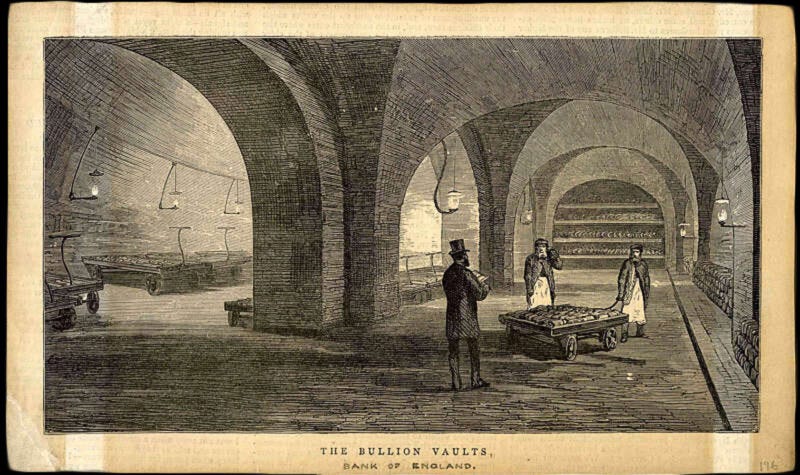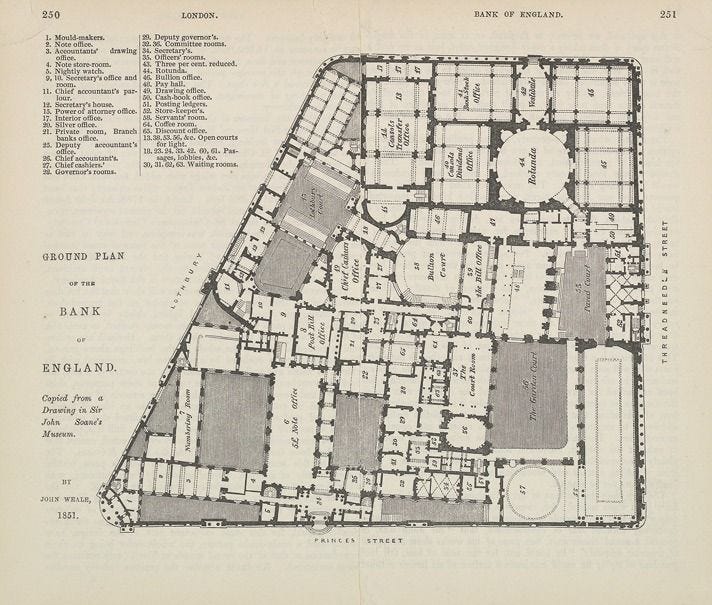The Enigma of the Old Lady: How Victorian Tunnels and Digital Lies Threaten the Bank of England’s Gold
From Gold's All-Time High to Victorian Sewer Rats & 21st-Century Shell Games: A Tale of the Bank of England’s Unseen War for Gold
In the mist-shrouded heart of Victorian London, where gas lamps flicker like wary sentinels and the cobblestones whisper tales of empire and intrigue, there stands a fortress of wealth and mystery: the Bank of England, affectionately dubbed the Old Lady of Threadneedle Street. Beneath her stoic façade lies a labyrinth of tunnels and vaults, guardians of gold, and the stuff of legends. But has this bastion of bullion ever been breached? Gather ‘round, dear reader, for a tale woven with history, shadow, and a dash of Sherlockian suspense.
A Fortress Beneath the Fog
The Bank of England, cornerstone of the London Bullion Market Association (LBMA), has safeguarded Britain’s gold since 1694. Its subterranean vaults—cavernous chambers buried deep beneath the city—hold over 400,000 gold bars, valued at a staggering £200 billion. The air here hums with the weight of history, and the very walls seem to murmur of clipper ships, sovereigns, and the clinking of imperial ambition.
Yet it is the tunnels that stir the imagination. Hidden beneath the Bank’s Romanesque edifice, these passageways were engineered in the 19th century to ferry gold securely between the vaults, the Royal Mint, and waiting ships at the Thames River. Rumors persist of secret routes branching toward the Tower of London or even Westminster—a subterranean network fit for a crown’s ransom.
The 1834 Bank of England Tunneling Plot
In early 1834, a daring plot to breach the Bank of England’s vaults unfolded under the leadership of William “The Old ’Un” Murphy, a seasoned criminal, and his wife Catherine, a shrewd operator with a history of theft and fraud. Alongside at least four accomplices, the couple targeted the Bank’s vast reserves of gold bullion and currency, devising a plan as audacious as it was meticulous.
William and Catherine Murphy’s gang rented a house near the Bank of England, posing as shopkeepers to mask their plot. From the cellar, they spent three months digging a 40-foot tunnel toward the Bank’s vaults by candlelight, disguising rubble as renovation debris. Their plan collapsed on November 3 when nightwatchman William Evans heard suspicious echoes; police stormed 3 West Street, finding the tunnel inches from success.
At the Old Bailey trial, Catherine’s unflappable demeanor captivated the press. The Murphys were transported to Australia, while accomplices received prison terms. The Bank responded with thicker walls and improved security, but the media’s “Great Bank Robbery” narrative spiraled into myth, embellished with tales of disguises and hypnotic gas.
The Great Fire & the Unyielding Vault
The Old Lady’s next trial came not from thieves, but from flame. In 1836, a disgruntled clerk set fire to the Bank’s records, unleashing an inferno that raged for days. Yet when the smoke cleared, the vaults stood unscathed, their iron doors and granite walls defiant. Luckily the gold, and the Bank’s reputation, emerged untarnished.
The Phantom Letters & the Sewer’s Secret
But mere months after the fire, the Bank faced a far stranger intrusion—one worthy of a penny dreadful. The tale, now enshrined as legend on the Bank’s own website, begins with a series of anonymous letters delivered to the directors in 1836. The writer made a ludicrous claim: they could enter the vault at will. The Bank’s governors dismissed it as folly—until the mysterious correspondent offered to meet them inside the vault itself.
Intrigued but incredulous, the directors agreed. On the appointed night, they gathered in the vault, lanterns casting long shadows over the stacks of gold. Then came the sound: a faint scraping beneath their feet. Suddenly, a floorboard shifted, and a disheveled figure emerged from the darkness—a Victorian sewer worker, reeking of the Thames and grinning like a Cheshire cat.
The man, whose name has vanished from history, explained how he’d discovered an ancient drain during repairs near Threadneedle Street. Curiosity led him to crawl through the crumbling brickwork—and straight into the heart of the Bank’s vault. Stocktaking later proved he’d stolen nothing, though he’d stumbled upon “all the gold in England.” The directors, equal parts horrified and relieved, rewarded him £800 (a life-changing £100,000 today) and sealed the drain. Yet whispers lingered: Why was his name erased? Had the Bank, mortified by the lapse, expunged the incident from official records?
The Case of the Vanishing Bullion
No tale of the Old Lady would be complete without a whisper of the uncanny. In 1897, as fog coiled through London like a spectral serpent, a rumor spread: a mastermind had infiltrated the vaults using the tunnels, vanishing with a king’s hoard. The press splashed headlines of “The Threadneedle Ghost,” while Scotland Yard scoffed. Yet an anonymous letter to The Times—signed only “S.H.”—hinted at a deeper game: “Observe the guards’ tea trolleys, for even a siphoned sovereign leaves traces.” The mystery dissolved, but to this day, some swear they hear the clink of phantom gold in the depths.
(The truth? A clerk had smuggled crumbs of gold in his lunch pail—a paltry crime swiftly solved. But where’s the fun in that?)
The Modern Citadel
Today, the Bank’s vaults are protected by seismic sensors, laser grids, and doors weighing 40 tons—a far cry from Melville’s pickaxes or the unnamed sewer rat’s serendipitous drain. The 1836 breach forced a sweeping redesign, burying the Old Lady’s secrets deeper still. Yet the allure remains. Notably, the Bank’s vaults remained intact until 1994, when a modern gang replicated the tunnel tactic—proving history’s peculiar resonance. In 2016, urban explorers claimed to find a forgotten tunnel near the Bank, sparking fevered speculation. Authorities dismissed it as a disused sewer, but conspiracy theorists purred: “The game is afoot!”
The Vault’s Silent Siege
But now, in an age of digital ledgers and algorithmic trades, the Old Lady faces a threat more insidious than any sewer rat or firebrand clerk. A modern-day rush for physical gold is underway, driven by governments, hedge funds, and wary investors fleeing paper promises. The LBMA’s vaults, once overflowing, are being drained bar by bar. Central banks repatriate their hoards; billionaires demand bullion in hand; ETFs scramble to back their shares with tangible metal.
The irony? The greatest heist in Threadneedle Street’s history may not be plotted by thieves but enabled by the vaults’ own custodians.
Enter rehypothecation—the alchemy of finance where a single gold bar is pledged to multiple owners, a shell game worthy of Professor Moriarty himself. As claims multiply and physical stocks dwindle, whispers grow: Are the vaults becoming hollow? Could the Old Lady, who withstood fire and folly, now guard nothing but air—a gilded illusion propped up by ledger entries?
The Death of the Old Lady
The Old Lady of Threadneedle Street has never been bested. Her vaults, like Arthur Conan Doyle’s riddles, defy solution. Yet, as Gold prices reach to a new all-time high of $3000, shadows lengthen over London, a new mystery unfolds. The clink of gold grows fainter; the tunnels echo emptily. Perhaps the final twist is this: after centuries outwitting pickaxes and flames, the vaults’ undoing may come not from without, but within—her death by ledger, a vanishing act written in ink.
So, next time you stroll past her hallowed walls, pause a moment. Listen for the echo of picks in the dark, the scuttle of a sewer rat, or the rustle of a thief in the shadows. For in London, even gold has ghosts… and the greatest enigma may still lie ahead.
“Come, Watson, come! The game is afoot…”
The Precious Metals Bull Markets have arrived.
Stay Vigilant,
-Tyler
Historical Note: While the LBMA itself was founded in 1987, the Bank of England’s vaults and tunnels have safeguarded gold for centuries. The 1836 sewer worker incident, though absent from official records, is corroborated by documented sewer repairs near Threadneedle Street. As for today’s “draining” vaults, experts debate whether rehypothecation risks are fact or fear—but in the City, where smoke often precedes fire, even whispers can reshape history.
If you found this story valuable, consider ‘tipping’ the modern equivalent: a $8/month pledge ensures investigations like this keep coming.











